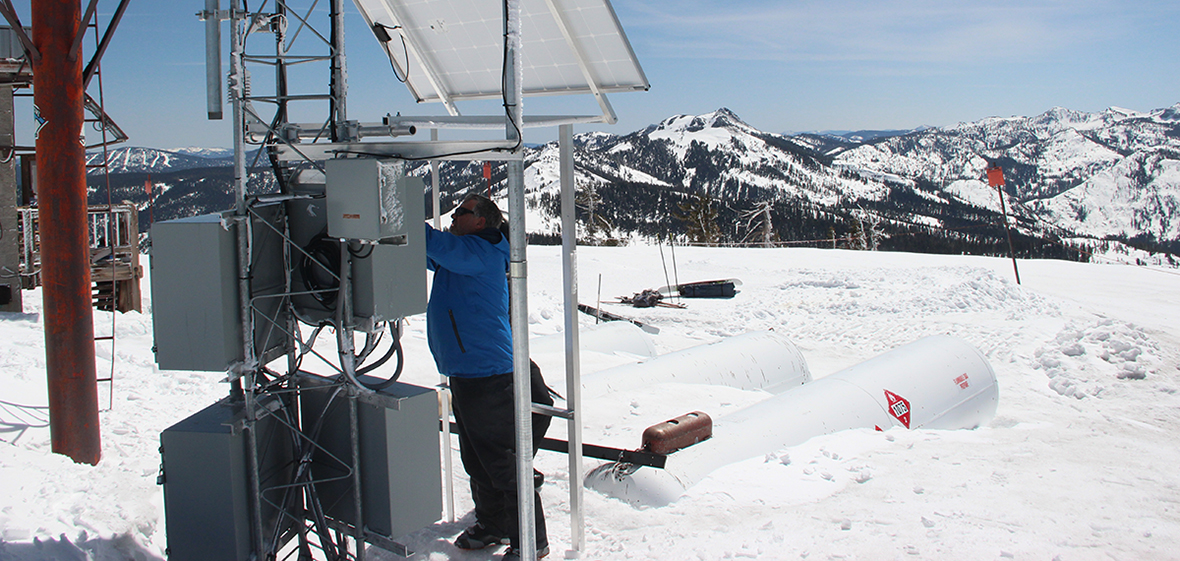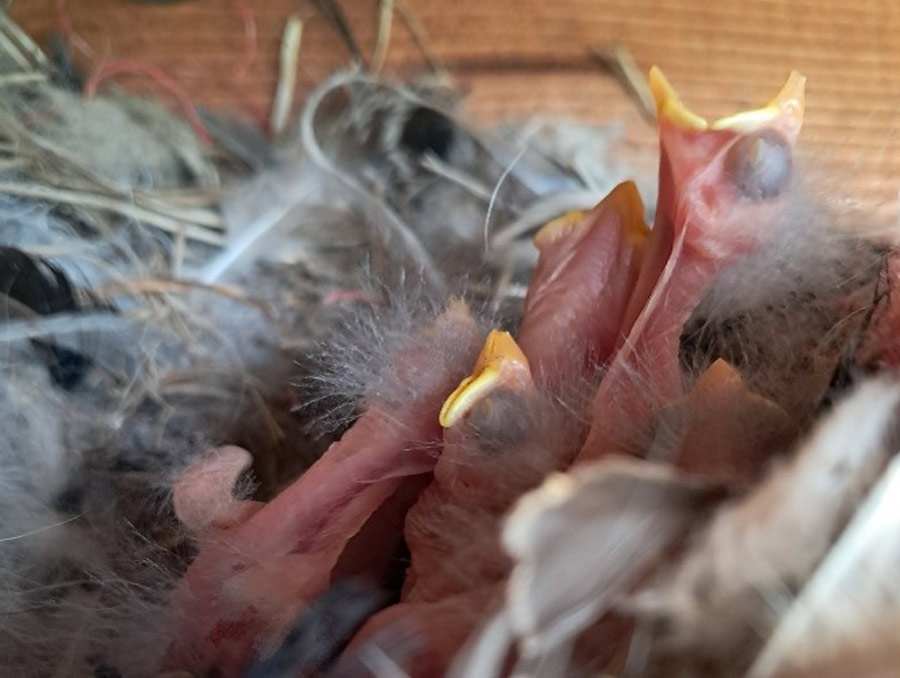Winds that tear weather gauges from their mountings and blizzards that bury chairlifts - this is the kind of weather that hits Donner Summit, and holds great interest to climatologists, meteorologists, hydrologists and water supply managers as well as creates one of the best regions for skiing in the world.
While this winter has been mild in comparison, strong winter storms like the 10 atmospheric river events that moved through the Northern Sierra Nevada region during the 2016-17 winter season are not uncommon. Those systems regularly generated 173-mile per hour winds and delivered more than 700-inches of snowfall, with the snowpack reaching depths of more than 20 feet. The extreme weather was recorded in part by new instruments and technologies placed on a mountaintop in a collaboration between the University of Nevada, Reno's Nevada State Climatologist's Office and Sugar Bowl Resort.
Scientists at the College of Science and officials at the Lake Tahoe area ski resort partnered to study regional weather and the impacts of climate change in the Northern Sierra by way of installation of three weather stations at the resort. The installation collects and provides important weather-related information that can be viewed by the public, updated every 10 minutes, and is shared with the National Weather Service, U.S. Forest Service and Sierra Avalanche Center daily. It can be viewed online at https://www.unr.edu/climate/climate-research/mwcl. In addition, the data collected provides Sugar Bowl Resort with important details relevant to their avalanche control and slope grooming operations.
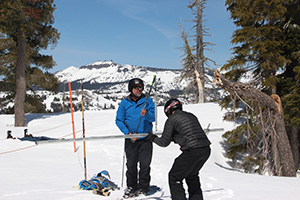
"Less than an hour from the University's campus in Reno, the nearly 8,400-foot summit of Mt. Lincoln is an ideal location for high-elevation climate observations," said Douglas Boyle, associate professor in the Department of Geography in the College of Science and director of the Nevada State Climate Office. "The University is interested in long-term monitoring of the weather and climate variables with the primary goal of observing changes in atmospheric winds, the associated high-elevation orographic-based precipitation, and the snowpack; the primary source of water for rivers, reservoirs, aquifers, agriculture, and millions of people in northern California and the east side of the Sierra Nevada."
Historical Weather Data Meets 21st Century
The Donner Summit area, where Sugar Bowl is located, has climate records that go back to the late 1800s and there are twice-daily records at the Sugar Bowl Ski Resort that go back for decades. It is one of the longest continuous ski resort snow-recording sites in the country, and the ski resort continues the record keeping.
The new weather stations are operated by an internet-based system that uses the University's AlertTahoe private high-speed microwave linked system that transmits real-time data, photos and video to scientists, public safety officials and Sugar Bowl's professional ski patrol. The high-definition cameras have been installed at all three weather station locations at the resort. The mid-mountain station is at 7,558 foot elevation and the base station is at 6,978 foot elevation. These locations were selected in coordination with the Sugar Bowl Ski Patrol to best represent areas with snow across the entire resort to assist in decision-making for avalanche control and forecasting throughout the region.
"Sugar Bowl benefits from this partnership by gaining access to accurate real-time observations of weather and snow conditions that can assist with our operational decision-making and communications to our guests," Greg Dallas, president and CEO of Sugar Bowl Resort, said. "Science-based snow reporting also offers the most consistent and authentic data available. We intend to use it to be even more transparent as it relates to our daily snow reporting. We also appreciate the value it brings to our entire region as the University team and other organizations receiving this data study the impacts of climate change in the Sierra."
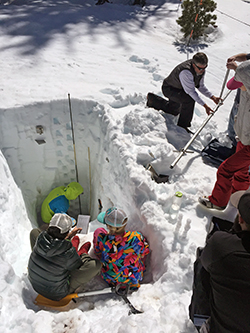
Advanced Climatology students dig a snow pit to get most accurate record of amount of liquid water equivalent in the snowpack. These numbers are used by hydrologists to forecast runoff to reservoirs used for domestic water supply.
The partnership between the University and Sugar Bowl dates back to May 2014 when the University's climate office was granted a 10-year permit to conduct high-altitude climate monitoring within the privately held property of the Sugar Bowl Corporation along the Sierra Crest near Donner Summit. Part of the 10-year permit includes the opportunity for University faculty to take advantage of this high-elevation climate observation network for educational purposes.
"This project has, and will, continue to serve as an excellent outdoor laboratory for studying mountain weather and climate," Boyle said. "Since 2014, dozens of undergraduate and graduate students from the University have had the opportunity to visit and work with our weather sites at Sugar Bowl to learn about monitoring extreme weather and climate conditions. Feedback from students has been overwhelmingly positive."
High-Altitude Extreme Weather Monitoring
Since October 2016, the science team has been observing and recording air temperature, relative humidity, wind speed, wind direction, barometric pressure, precipitation, snow depth, water content and snow surface temperature automatically at the three Sugar Bowl Resort sites. Automated precipitation sensors were installed this year and the installation of automated water content, snow depth, and net solar radiation sensors will be installed early this summer.
"Sugar Bowl has been an amazing partner and collaborator on this project," Boyle said. "Together, we have already learned a lot about the challenges associated with keeping these real-time observations available during extreme weather conditions, including transmitting microwave signals through 30- to 40-foot snow drifts, AC power outages, and heavy ice riming issues on the mountaintop equipment.
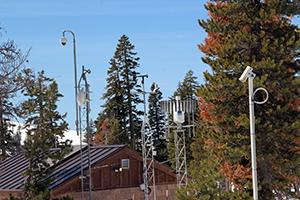
State-of the-art recording instruments are used to monitor a dozen weather, climate and hydrological data. This is the mid-mountain station at the Sugar Bowl Resort.
In spring of 2016, the climate office partnered with Graham Kent, a geosciences professor and the Nevada State Seismologist at the University of Nevada, Reno, to include these weather/climate sites at Sugar Bowl Resort in the Nevada Seismological Laboratory's multi-hazard monitoring and communications network that includes earthquakes, wildfire and extreme weather observations.
The state-of-the-art camera system, part of the AlertTahoe fire camera network, also provides real-time data, photos and video to first-responders, scientists, public safety officials and other interested parties, and offers the ski area access to weather-related data that assists with their avalanche forecasting and mitigation, and snow reporting accuracy. The University of Nevada, Reno's Nevada Climate Office installed, maintains and operates the equipment.
The wilderness internet network includes 25 fire cameras along the Sierra crest as far south as Mammoth Lakes and BLM lands in northern Nevada. Another 10 cameras have already been funded and slated for installation this spring and summer. The addition of the extreme weather observations in the network will provide much needed real-time weather information to better understand avalanche conditions in the Sierra, snow levels over mountain passes, and aviation conditions in the region.
